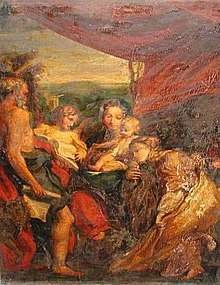Emma Jane Greenland
| Emma Jane Greenland Hooker | |
|---|---|
| Born |
Emma Jane Greenland 1760 London, England |
| Died |
1843 London |
| Occupation | painter, writer, singer |
| Language | English |
| Nationality | British |
| Subject | encaustic painting |
| Spouse | Mr. Hooker |
Emma Jane Greenland (later, Emma Jane Greenland Hooker; 1760–1843) was an English painter, writer and singer. She was awarded a Gold Pallet on 14 November 1786 by the Society at London for the Encouragement of Arts, Manufactures, and Commerce.[1] Greenland may have been a pupil of Johann Sebastian Bach, and she owned some of his manuscripts after his death.[2]
Early years and education

Emma Jane Greenland was born in London in 1760. Her father is thought to be Augustus Greenland.[2] In the decade from 1772 to 1782 she studied painting with Francesco Bartolozzi at the Incorporated Society of Artists in London as well as with Giovanni Battista Cipriani and Giovan Battista Capezzuoli at the gallery of the Duke of Richmond. In order to perfect her work, she moved to Italy and in 1783, in Rome, began studying encaustic painting with Joseph Pignatelli. In 1785, in Florence, she practiced encaustic painting at the salon of Irene Parenti Duclos and thanks to her, Hooker began to attend the Royal Gallery.
Career
She returned to London in 1786, and in the following year, published Curios discovery of the ancient grecian method of painting on wax. Greenland also exhibited her self-portrait, at the Royal Academy of Arts in London as an Honorary Exhibitor.
Her first communication to the Society for the Encouragement of Arts, Manufactures, and Commerce of London, with examples of this mode of painting, was made in the year 1786,[3] one example of which was preserved in the Society's rooms at the Adelphi. For her very successful efforts in encaustic painting, Greenland was presented with a gold palette by the Society in 1786. Her account was printed in the 10th volume of the Society's Transactions for the year 1792. In the year 1807, she made a farther communication to the Society of the result of no less than 50 experiments per day, during more than four months.[4] It was proposed that this methos painting should be called the Hookerian method.[3]
From 1801, with her husband, she directed a school for young aristocracy in Sussex, which included the grandchildren of the Duke of Wellington and Napoleon Bonaparte as students. Greenland's music career gave her great satisfaction as when Johann Christian Bach dedicated to her six sonatas for piano and violin. Her father was a witness to Bach's will and Emma wrote her name on the title page of each document and at the head of each movement. Emma may have been a pupil of Bach's.[2]
She died in London in 1843.
References
- ↑ Ostell 1801, p. 138.
- 1 2 3 Paul Corneilson (5 July 2017). J.C. Bach. Taylor & Francis. pp. 360–362. ISBN 978-1-351-56188-4.
- 1 2 James Elmes (1826). A General and Bibliographical Dictionary of the Fine Arts: Containing Explanations of the Principal Terms Used in the Arts of Painting, Sculpture, Architecture, and Engraving, in All Their Various Branches; Historical Sketches of the Rise and Progress of Their Different Schools; Descriptive Accounts of the Best Books and Treatises on the Fine Arts; and Every Useful Topic Connected Therewith. T. Tegg. pp. 312–.
- ↑ Elmes 1826, p. 312.
Attribution


Bibliography
- Algernon Graves, A Dictionary of Artists who have exhibited works in the principal London Exhibitions from 1760 to 1893, London, 1901
- Fabia Borroni Salvadori, Artisti Viaggiatori e il Mito di Raffaello, in "Rassegna Storica Toscana", Firenze, 1984
- A Dictionary of British and Irish Travellers in Italy 1701-1800, Yale University Press, New Haven and London, 1997
- E. Bénézit, Dictionnaire des peintres, sculpteurs, dessinateurs et graveurs, Libreraire Grunde, Paris 1999
- Alberto Macchi, Irene Parenti, atto unico teatrale tra realtà e ipotesi, Note, AETAS, Roma, 2006